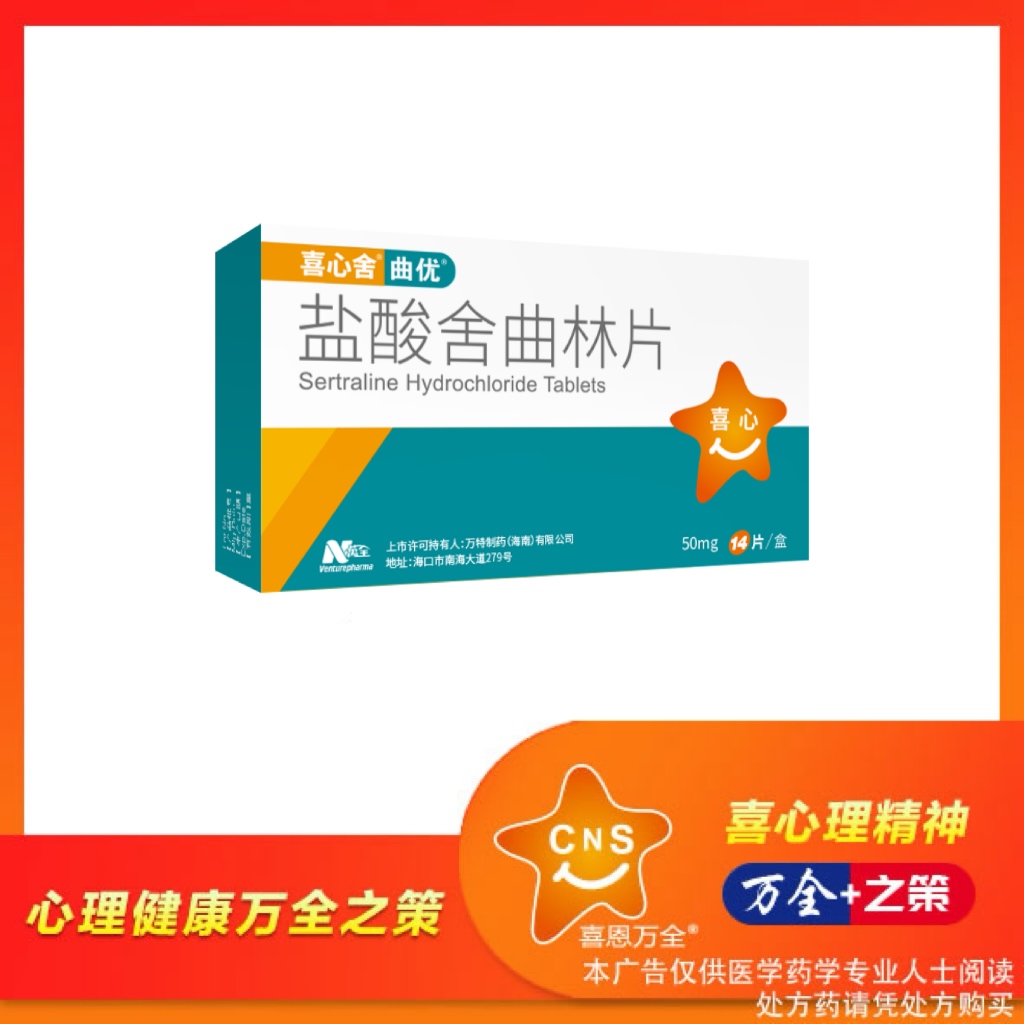【 Drug name 】
Generic name: Sertraline hydrochloride tablets
Product Name: Sertraline hydrochloride tablets (Quyou)
English name: Sertraline Hydrochloride Tablets
Full Pinyin code: YanSuanSheQuLinPian(QuYou)
[Main ingredients] The main ingredient of this product is sertraline hydrochloride.
【 component 】
Molecular weight: C17H17NCl2·HCl
[Nature] This product is a white film coat, after removing the film coat, it looks like white.
Sertraline is used to treat symptoms associated with depression, including depression with anxiety, with or without a history of mania. After satisfactory results, continuing sertraline can effectively prevent the recurrence and recurrence of depression. “Sertraline is also used in the treatment of obsessive-compulsive disorder, and sertraline retains its efficacy, safety, and tolerability up to 2 years after an initial treatment response.”
[Specification Model] 50mg*14s(Quyou)
[Usage and dosage] Adults take the medicine once a day, either early or late, with or without food. The usual effective dose for depression and obsessive-compulsive disorder is 50 mg/day. A few patients with poor efficacy and good tolerance to the drug can gradually increase the drug dose by 50 mg each time within a few weeks according to the efficacy of the drug, up to 200 mg/day, once a day. Since the elimination half-life of sertraline is 24 hours, the interval between dose adjustments should not be shorter than 1 week. The therapeutic effect can be seen in about 7 days of medication, and the full effect can be seen in 2 to 4 weeks. The effect of OCD may take longer to appear. For long-term use, the dose should be adjusted according to the efficacy and maintained at the lowest effective therapeutic dose.
【 Adverse reactions 】 1. According to the literature, in controlled clinical studies of sertraline and placebo for depression, the common adverse effects are as follows: Autonomic nervous system: dry mouth and hyperhidrosis. Central and peripheral nervous system: vertigo and tremor. Gastrointestinal tract: diarrhea/loose stools, dyspepsia, and nausea. Mental: anorexia, insomnia, and lethargy. Reproductive system: sexual dysfunction (mainly delayed ejaculation in men). 2. Sertraline tablets have been available for many years. According to the literature, the following adverse events were reported spontaneously by patients while taking sertraline: Autonomic nervous system: pupil dilation and priapism. Systemic: anaphylaxis, anaphylaxis, anaphylactoid reactions, asthma, fatigue, fever, flushing, malaise, weight loss, weight gain. “Cardiovascular system: chest pain, peripheral edema, hypertension, palpitations, periocular edema, syncope, and tachycardia.” “Central and peripheral nervous system: coma, convulsions, headache, migraine, movement disorders (including extrapyramidal side effects such as hyperactivity, hypertonia, bruxism, and abnormal gait), involuntary muscle contractions, paresthesia, and hypoesthesia.” “There are also signs and symptoms associated with the serotonin syndrome, such as anxiety, confusion, diaphoresis, diarrhea, fever, hypertension, myotonia, and tachycardia associated with the concomitant use of serotonergic drugs.” Endocrine system: galactorrhea, gynecomastia, hyperprolactinemia and hypothyroidism, ADH secretion disorder syndrome. “Gastrointestinal system: abdominal pain, increased appetite, constipation, pancreatitis, and vomiting.” Hearing/vestibular function: Tinnitus. “Hematological system: changes in platelet function, abnormal bleeding (such as epistaxis, gastrointestinal bleeding, or hematuria), neutropenia, purpura, and thrombocytopenia.” Laboratory changes: Clinical laboratory findings were abnormal. “Hepatobiliary system: severe liver disease (including hepatitis, jaundice, and liver failure) and asymptomatic elevation of serum transaminases (SGOT and SGPT).” Metabolic/nutritional system: hyponatremia and elevated cholesterol. Musculoskeletal system: arthralgia. “Mental disorders: anxiety, aggressive reactions, worry, depressive symptoms, euphoria, hallucinations, decreased sexual desire in women, decreased sexual desire in men, nightmares, psychosis, and yawning.” Reproductive system: Irregular menstruation. Respiratory system: Bronchospasm. “Skin systems: alopecia, angioedema, skin photosensitivity, pruritus, rash (rarely desquamative dermatitis, such as erythema multiforme :Stevens-Johnson syndrome, epidermal nectolysis), and urticaria.” Urinary system: facial edema, urinary incontinence and urinary retention. Vision: Abnormal vision. “Other: reported symptoms after discontinuation of sertraline include: anxiety, worry, vertigo, headache, nausea, and paresthesia.” (See package instructions for details)
【 Contraindication 】 Contraindication to sertraline allergy; Concomitant use with monoamine oxidase inhibitors is prohibited. ?
【 Notes 】 1. Careful consideration should be given to the combination of sertraline with drugs that increase serotonergic nerve transmission, such as tryptophan or fenfluramine, to avoid possible pharmacodynamic interactions. 2. The optimal timing of switching from other serotonin-reuptake inhibitors, antidepressants, or antiobsessive-compulsive medications to sertraline therapy is not known. When switching therapy, especially with long-acting drugs such as fluoxetine, care should be taken and careful pharmacodynamic evaluation and monitoring should be performed. The wash-out period for switching treatment from a selective serotonin-reuptake inhibitor to another agent has not been defined. “Activation of mania/hypomania: Approximately 0.4% of sertraline treated patients developed hypomania or mania during the premarketing trial.” “Mania or hypomania has also been reported in a small number of patients with other marketed antidepressants or anti-obsessive-compulsive drugs for the treatment of affective disorders.” 3. Both antidepressants and anti-obsessive-compulsive drugs have the potential to induce seizures. In all trials of sertraline for depression, about 0.08% had seizures; No seizures have been reported in trials of sertraline in the treatment of panic disorder. Among about 1800 patients with OCD treated with sertraline, 4 (about 0.2%) had seizures: 3 patients were adolescents, 2 patients had epilepsy, and 1 patient had a family history of epilepsy, all of whom were not receiving antiepileptic drugs. All seizures have not been determined to be directly related to sertraline treatment. “Sertraline has not been evaluated in epileptics and should be avoided in unstable epileptics.” Patients with controlled epilepsy should be closely monitored, and any patient who develops seizures while taking sertraline should stop taking the drug. 4. “Because of the potential for suicide attempts in depressed patients, which may persist until clinically significant remission is achieved, patients at risk for suicide should be closely monitored early in treatment.” Because obsessive-compulsive disorder and depression have been shown to co-occur, patients with obsessive-compulsive disorder should also be monitored for suicidality when they are treated. 5. Women of childbearing age using sertraline should use adequate and safe contraceptive methods. 6. Although clinical pharmacological studies showed that sertraline had no effect on psychomotor activity. However, the use of antidepressant and anti-obsessive-compulsive drugs may affect the energy and physical performance necessary to perform potentially dangerous tasks such as driving a car or operating machinery. Therefore, caution should be exercised when using sertraline in these patients. 7. Patients with hepatic insufficiency: Sertraline should be used with caution in patients with concomitant liver disease. The dose or frequency of medication should be reduced in patients with impaired liver function. 8. Patients with renal insufficiency: There is no need to adjust the dose of sertraline according to the degree of renal impairment. Please read the instructions carefully and follow the instructions.
“Although sertraline is metabolized more rapidly in children, lower doses are recommended in order to avoid high plasma concentrations, especially in underweight children aged 6 to 12 years.”
The dose range for elderly patients is the same as that for younger patients. More than 700 older patients (> 65 years of age) were enrolled in clinical trials that confirmed the efficacy of sertraline in this population. The pattern and incidence of adverse effects in older patients were similar to those in younger patients.
Use for pregnant and lactating women. “Reproductive toxicity studies have been carried out in rats and rabbits, with no evidence of teratogenicity at dose levels 20 and 10 times the maximum dose used in humans (in milligrams /kg/ day).” “However, at dose levels (mg/kg/ day) equivalent to 2.5 to 10 times the maximum dose used in humans, sertraline has been associated with delayed ossification of embryos, with possible secondary effects on the embryonic barrier.” At dose levels approximately 5 times the maximum dose in humans (measured in milligrams per kilogram per day), maternal sertraline was associated with reduced survival of newborn pups. “Reduced survival of newborn infants has also been described with other antidepressants, and the clinical significance of these effects is unclear.” There have not been enough well-controlled studies of pregnant women. Pregnant women should use it only if the benefits outweigh the risks. Data on sertraline concentrations in milk are limited. Sporadic studies of small sample sizes of lactating mothers and infants suggest that, although sertraline concentrations are higher in breast milk than in serum, sertraline concentrations in infant serum are very low or undetectable. Breast-feeding women should use it only if the benefits outweigh the risks. When sertraline is taken during pregnancy and/or lactation, physicians should be aware of symptoms of withdrawal reactions. The mother had taken serotonin-based antidepressants, including sertraline, and the newborn had similar withdrawal
Load more




![[Xienka] 28s· Let love not dementia, let mother remember who I am](http://www.eng.venturepharma.cn/wp-content/uploads/2025/06/97cf67df18de4fc78aebf86a056486d3-300x300.png)